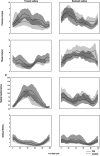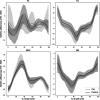Muscle activation patterns during backward walking in people with chronic ankle instability
- PMID: 32711488
- PMCID: PMC7382804
- DOI: 10.1186/s12891-020-03512-x
Muscle activation patterns during backward walking in people with chronic ankle instability
Abstract
Background: Altered walking patterns are often described in individuals with chronic ankle instability (CAI). Contemporary treatment paradigms recommend backward walking (BW) to improve locomotion in people with musculoskeletal disorders. The purpose of this study was to determine whether muscle activity and activation variability during BW differs between subjects with and without CAI.
Methods: Sixteen participants with CAI and 16 healthy controls walked on a treadmill at their self-selected speed under BW and forward walking (FW) conditions. Surface electromyography (EMG) data for the peroneus longus, tibialis anterior, medial gastrocnemius and gluteus medius muscles were collected. EMG amplitude normalized to maximum voluntary isometric contraction (%MVIC) and the standard deviation (SD) of the %MVIC EMG amplitude was calculated throughout the gait cycle. In addition, the area under the curve (AUC) of the %MVIC EMG amplitude was calculated before and after initial contact (pre-IC: 90-100% of stride; post-IC: 0-10% of stride).
Results: No differences between groups were noted in the %MVIC amplitude or activation variability (SD of %MVIC EMG) under BW or FW. In both groups, decreased tibialis anterior (p < 0.001) and gluteus medius (p = 0.01), and increased medial gastrocnemius (p < 0.001) activation were observed during pre- and post-IC under BW condition.
Conclusion: Participants with CAI and healthy controls have similar muscle activity patterns during BW. Yet, the results should be interpreted with caution due to the heterogeneity of the CAI population.
Keywords: Chronic ankle instability; Electromyography; Walking.
Conflict of interest statement
The authors declare no competing interests.
Figures




References
-
- Gribble PA, Delahunt E, Bleakley C, Caulfield B, Docherty CL, Fourchet F, et al. Selection criteria for patients with chronic ankle instability in controlled research: a position statement of the international ankle consortium. J Orthop Sports Phys Ther. 2013;43:585–591. doi: 10.2519/jospt.2013.0303. - DOI - PubMed
MeSH terms
LinkOut - more resources
Full Text Sources

